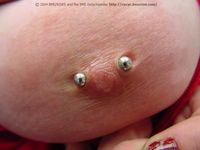Small Nipple Bar
If the barbell used for a nipple piercing is too short, the beads can sink into the nipple. If it actually goes fully inside, the skin can close around it. In addition, the bead can act as a plug and cause an abscess, or worse, to form.
While it is more of an issue for women than men, both genders are susceptible. Pressures from the jewelry not fitting correctly (as with a small nipple ring) can lead to migration and rejection, to say nothing of the generally less-than-ideal aesthetics of the placement.
Nipple barbells should fit snugly to avoid getting snagged and so on, but they should not be putting any pressure on surrounding tissue and there should be a small amount of play in them.
Until a piercing is very well healed, the beads of a barbell should never be tight and putting pressure on the piercing.
